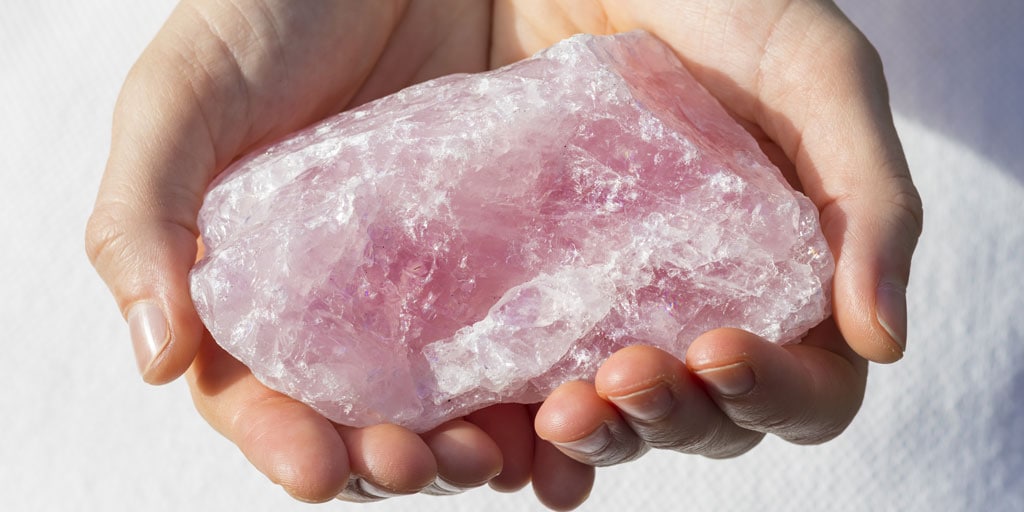
Is your rose quartz genuine? Here are five simple tests for this heart-centred crystal.
Rose quartz is a beautiful healing crystal that’s associated with love and peace. It’s linked with the Heart Chakra and is often used for self-love, managing grief, and manifestation.
While rose quartz is one of the rarer forms of quartz, it’s still quite abundant and easy to find.
For this reason, it’s not a commonly faked gemstone. Most rose quartz you see in stores or jewellery is likely to be real, assuming it’s bought from a reputable retailer.
With that said, it’s still helpful to understand how to spot fake rose quartz. I also think it’s important to recognise when a stone has been altered to enhance its appearance.
How To Tell The Difference Between Real And Fake Rose Quartz?
While the majority of rose quartz is real, any fakes are probably made with dyed glass. Rose quartz is harder than glass, so you can perform a scratch test to check that it’s genuine. Highly saturated colours, lightness, lack of imperfections, transparency, and air bubbles are also signs that a rose quartz crystal could be fake.
What Does Authentic Rose Quartz Look Like?
Before you can spot a fake rose quartz crystal, you need to understand the stone’s natural appearance.
Genuine rose quartz has an imperfect appearance. It contains flaws, misty sections, and white streaks. Rose quartz doesn’t contain air bubbles though.
Unlike glass, rose quartz is typically not transparent. It’s often translucent with a cloudy appearance, although some rose quartz can be opaque if it contains lots of imperfections.
In terms of colour, rose quartz can vary from pale to medium-dark pink. The colour comes from dumortierite inclusions, although some stones may also contain trace amounts of amethyst which gives a purple hue.
Finally, rose quartz rates as a seven on the Mohs Hardness Scale for crystals. This makes it a relatively hard gemstone, although it’s softer than topaz and diamond.
Is Rose Quartz Rare And Expensive?
Rose quartz is rarer than many forms of quartz, but it’s still an affordable gemstone. It’s also mined in large quantities, which is why it’s such an abundant crystal.
The exact price of rose quartz varies depending on the size and quality of the stone. The colour can also affect the stone’s price. As a general rule, you can often buy a 50g rose quartz crystal for around $2-4.
This low price is one of the reasons why fake rose quartz isn’t a common problem. It simply isn’t worth the time and money to try and fake it.
5 Ways To Identify Real Rose Quartz Crystals
As rose quartz is a relatively cheap stone, it’s less likely to be fake. However, here are five tests you can use to check whether rose quartz is genuine.
I recommend performing several of these tests if you really want to know whether a rose quartz crystal is real. Some of the tests are subjective, so combining them gives a more accurate result.
1. Hardness
As I mentioned earlier, rose quartz rates as a seven on the Mohs Hardness Scale. Glass has a hardness of around 5.5, so you can test whether rose quartz is real by using it to scratch glass.
It’s best to use a glass bottle for this, as you don’t want to ruin anything valuable! This method is also best for raw crystals, rather than tumbled rose quartz.
2. Saturation
Rose quartz is naturally pale to medium pink.
While colour does vary, you should be wary of any rose quartz that has a highly saturated and bright pink colour. The more saturated the colour, the more likely it is that the crystal has been altered in some way.
3. Weight
Rose quartz is denser than glass. This means that a genuine rose quartz crystal will feel heavier than a glass fake of the same size.
Unfortunately, the difference is often only noticeable when you can directly compare two stones. Without a real rose quartz crystal you can trust, it can be hard to rely on weight alone.
Still, it’s worth keeping in mind that a crystal that feels very lightweight may not be real.
4. Transparency and Imperfections
Real rose quartz is not transparent. You can’t see clearly through it, as it contains cloudy patches, mistiness, and other imperfections.
For this reason, a stone that’s transparent is more likely to be glass. This is especially true if the crystal is highly saturated with a deep pink colour.
Similarly, real rose quartz contains inclusions and other blemishes. If the crystal is completely uniform without imperfections, then it’s more likely to be a fake.
5. Air Bubbles
Air bubbles form in glass during the cooling process. Bubbles are not common in rose quartz though, so they are a giveaway that the crystal is more likely to be fake.
It’s important to remember that rose quartz will contain imperfections. They are just unlikely to be smooth and round bubbles.
What About Temperature?
Genuine rose quartz should feel cool to touch, although it will warm up as you hold it.
However, glass also feels cool, so this isn’t a reliable method for checking if rose quartz is real. You can use temperature to check for plastic fakes, but these are even less common than glass.
Summary
Rose quartz is a common crystal that’s typically sold for an affordable price. That means it’s less lucrative to create fake rose quartz stones.
Even so, it’s always a good idea to check that a crystal is real. The methods above can help you discover whether your stone is genuine rose quartz or a glass fake.
Do you have any questions about how to check whether rose quartz is real? Or would you like to learn more about this beautiful gemstone? Please let me know in the comments section below.
